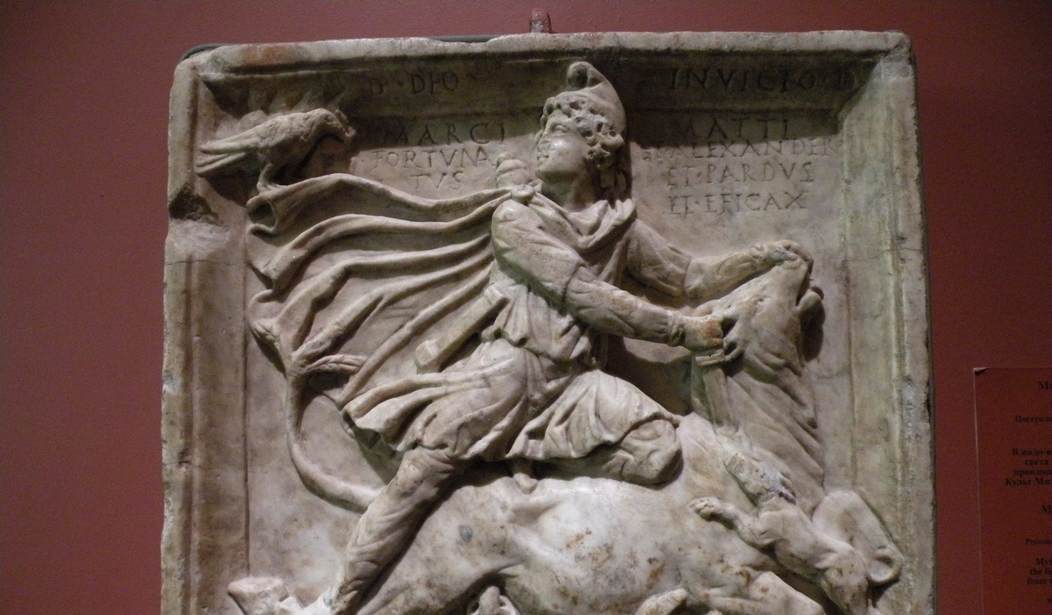I have had skeptics of the Christian faith tell me that very little of the New Testament story of Jesus is original. According to some critics, like novelist Dan Brown in his “The Da Vinci Code,” first century Christians just copied ideas about Jesus from a popular Roman religion known as “Mithraism.” Mithra was indeed a god of the ancient people of India and Persia, and over a period of time, followers of Mithra migrated to the Roman Empire. Soon, the story goes, the followers of Jesus incorporated legends of this sun-god of the Persians.
For example, according to stories circulating in modern fiction (and supposed “facts” people have told me) Mithra was born of the virgin goddess Anahita on December 25. Mithra was a great teacher and had 12 disciples. Mithra sacrificed himself and was resurrected and ascended into heaven. His followers eat cakes, symbolizing his body, to commemorate his life, death, and resurrection. Mithra’s disciples also practiced baptisms for new converts, and Mithraism was a missionary faith that competed with Christianity in the first century (however Mithraism died out after the fifth century).
Here is a very good video detailing the supposed similarities and distinctions between early Christianity and Mithraism:
If you listen to the skeptics, it sounds like Christianity was not so unique after all, doesn’t it? These parallels would be pretty convincing … except that almost none of it is true. Many of these supposed similarities are either terribly exaggerated or simply made up.
But let’s back up to what we know and don’t know about this interesting Roman religion. The first thing that stands out in an historical/critical analysis of Mithraism is that we have almost zero literary evidence about its beliefs. In fact, the only literature we do have about Mithraism is from either Christian writers (like Tertullian in the late second and early third century), or Platonic writers (like Plutarch). It seems that historically the religion of Mithra in the Roman Empire developed AFTER the Christian faith, not before or during the days of the apostles.
The religion of Mithra simply has NO sacred texts — no holy scripture — available to us. This is very unlike Christianity, which incorporates the Hebrew Old Testament and the later revelation of the New Testament, and has mountains of manuscripts of the New Testament in Greek with various translations in Latin and Syriac, as well as commentaries and lectionaries.
Because of the lack of literature regarding this religion, we know next to nothing about its beliefs and the meaning of its paintings, statues, and inscriptions. What people say about it is actually more urban legend than anything factual. Mithraism was a “mystery” religion that kept its beliefs pretty “close to the vest” — revealed only to its initiates.
In fact, most scholarship today (both Christian and non-Christian alike) admits that it is impossible to make the case that the ideas that are similar to Christianity were ever taught earlier than the second century. That would be quite a while after the New Testament was written and in circulation.
Okay, so what do we know about this religion? We know:
1. No virgin birth.
There was no virgin birth of Mithra. Usually Mithra is portrayed as born from a rock, fully grown, and Anahita was his consort. Far, far different from the story of Jesus begin born of the Virgin Mary.
In another account, Plutarch says that he was born on the shore of the river Anaxes. Nothing about a stable, swaddling clothes, or wise men, or an attempt on his life by an evil king.
2. No disciples.
There is no record at all of Mithra being a great teacher or having twelve disciples. So, when your skeptic friend says “well Mithra had twelve disciples too” he is merely believing urban legend, and nothing based in actual hard historical evidence.
3. No resurrection.
There is no record at all that Mithra was bodily resurrected. One myth is that he was taken to heaven in a chariot alive (maybe the followers of Mithra had borrowed their idea from the Old Testament story of Elijah?).
Again, no death and no resurrection. Nor is there anything like Mithra dying a sacrificial death for the sins of mankind. Alas, Jesus of Nazareth is — once again — unique in that distinction.
4. No women.
Mithraism was a faith embraced by the Roman military and civil servants. There are no records anywhere of any female followers of Mithra. It was also a syncretistic faith, embracing ideas from various other religions. Christianity, in contrast to Mithraism, welcomed women into its ranks (throughout the New Testament, women play a prominent role in the formation of the church).
The Christian faith also invited people of ALL socio-economic strata to believe in Christ and be a part of His church. In the first century, the apostles were VERY exclusivistic in their preaching. Paul, Peter, and John in their epistles warned against the influence of pagan philosophy or Judaistic law-keeping infiltrating the church. (Over the next several hundred years, however, pagan influence did creep into the Church and influence it to some degree.)
5. No historical grounding.
The events of the New Testament are grounded in history. There is zero evidence that Mithra existed. Jesus, on the other hand, appears in the works of Roman and Jewish historians.
Virtually all of the secular people mentioned in the Bible (Sennacherib, Nebuchadnezzar, Belshazzar, Caesar Augustus, Lysanias, Herod the Great, the Roman governors Felix and Festus, etc.) are true historical people. Virtually all geographical locations in the Bible are confirmed in history (there is a reason why there are maps in the back of Bibles today).
However, the modern reconstruction of the pagan “mystery” religion of Mithraism is pure fiction, not based in the factual history of any religious leader.
6. No baptism, no Last Supper.
But what about baptism and the Lord’s Supper? Don’t those rituals come from Mithraism? The first Christians were Jews who believed in the Old Testament, and developed their ideas about the Lord’s Supper and baptism from the Jewish Scriptures. The Eucharist/Communion/Lord’s Supper comes straight out of the Jewish observation of the Passover (which was instituted during the Exodus from Egypt around 1446 B.C.).
Water baptism has its historical roots in the ceremonial water purification rites instituted in the Law of Moses (e.g. Leviticus 4:6; 8:6), certainly not in any pagan ceremonies. There is absolutely no historical connection linking these two Christian rites with Mithraism.
7. December 25?
There is only one thing that the Christians definitely adopted from the pagans in this early Church time period … and that is affixing the date of December 25 as the day to commemorate the birth of Jesus. One Christian writer of that day said, “We hold this day holy, not like the pagans because of the birth of the sun, but because of Him who made it.”
The Bible, of course, nowhere records the birth of Jesus as being on December 25, and the exact date of Christ’s birth is unknown and unimportant in Christian theology. It seems the early Christians chose the date after the Pagan Roman festival of Saturnalia. There is no evidence linking December 25 to Mithraism, however.
So, if you hear one of these popular myths that Christianity got its ideas about Jesus from other religions floating around at that time, tell your friend that the burden of proof is on them to produce the evidence for their beliefs. And unlike Christianity, they have very little evidence, if any at all.









Join the conversation as a VIP Member